

Ramses VI. Grab KV 9. Der Plan des Grabs folgt den in der 19.
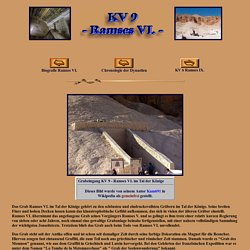
Dynastie geltenden Richtlinien, auch wenn die Schachtanlage fehlt und an der rechten Seite der ersten Pfeilerhalle (E bei Abitz) kein Nebenraum abzweigt. Auch fehlen die Nebenräume der Sargkammer, deren Ausbau jedoch nicht vollendet wurde. Seit der Zeit von Thutmosis IV. kann die Entwicklung der Bauform des königlichen Grabes als abgeschlossen angesehen werden. Seit dieser Zeit besteht die königliche Grabanlage aus einem oberen Grabbereich mit 3 Korridoren, den Schachtraum und der ersten Pfeilerhalle sowie einem unteren Grabbereich mit dem Abhang aus dem 1. Pfeilersaal (der Abgang aus dem 1. Beim Aushauen des linken Deckenteils am Ende des zweiten unteren Korridors (5. Ägypten - Lexikon... Begriffe rund um Ägypten leicht erklärt. Ancient Egypt Demons and Spirits part 1/6. Ancient Demons and Spirits part 1/6 Texts and reliefs in the great Egyptian temples of the second millennium BC portray a cosmos inhabited by deities, kings and humanity.
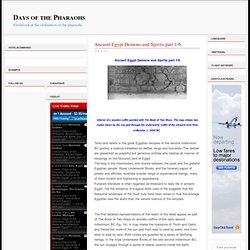
The deities are presented as powerful but generous entities who bestow all manner of blessings on the favoured . The king is the intermediary who stands between the gods and the grateful Egyptian people. Royal Underworld Books, and the funerary papyri of priests and officials, illustrate a wider range of supernatural beings, many of them bizarre and frightening in appearance Funerary literature is often regarded as irrelevant to daily life in ancient . DigitalHeka. Harem. Im ägyptischen Museum von Turin wird ein Papyrus aufbewahrt, der von einem der schaurigsten Verbrechen berichtet, das je im alten Ägypten begangen worden ist.
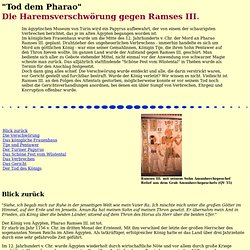
Im königlichen Frauenhaus wurde um die Mitte des 12. Jahrhunderts v. Chr. der Mord an Pharao Ramses III. geplant. Drahtzieher des ungeheuerlichen Verbrechens - immerhin handelte es sich um Mord am göttlichen König - war eine seiner Gemahlinnen, Königin Tije, die ihren Sohn Pentawer auf den Thron hieven wollte. Im ganzen Land wurde der Aufstand gegen Ramses III. geschürt.
Blick zurück. DemonThings - Ancient Egyptian Demonology Project. The Creation of The Gods and Humans. How the Gods Came To Be In the beginning, there was only chaos, which stretched, dark and silent, throughout all space and eternity.
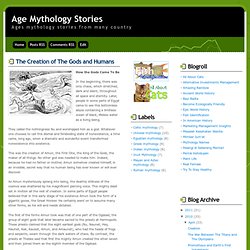
Later, people in some parts of Egypt came to see this bottomless abyss containing a limitless ocean of black, lifeless water as a living being. They called the nothingness Nu and worshipped him as a god. DemonThings - Ancient Egyptian Demonology Project. The Story of Isis and Osiris. In the days before Re had left the earth, before he had begun to grow old, his great wisdom told him that if the goddess Nut bore children, one of them would end his reign among men.
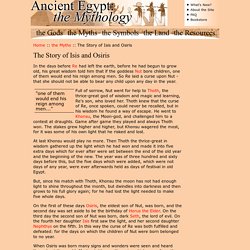
So Re laid a curse upon Nut - that she should not be able to bear any child upon any day in the year. "one of them would end his reign among men... " Full of sorrow, Nut went for help to Thoth, the thrice-great god of wisdom and magic and learning, Re's son, who loved her. Thoth knew that the curse of Re, once spoken, could never be recalled, but in his wisdom he found a way of escape. He went to Khonsu, the Moon-god, and challenged him to a contest at draughts. At last Khonsu would play no more. But, since his match with Thoth, Khonsu the moon has not had enough light to shine throughout the month, but dwindles into darkness and then grows to his full glory again; for he had lost the light needed to make five whole days.
When Osiris was born many signs and wonders were seen and heard throughout the world. Navigationshilfe. Echnaton. Aegypten. Die Verwandlung von Hathor, auch mit Online Shop Esoterik Versand. Mit Hilfe von Thot machte Re sie betrunken und verwandelte sie in die Göttin Hathor, die nun über die Schönheit, den Frieden, die Liebe und die Kunstwachen sollte.

Hathor beugte sich über den weinenden Horus, ihrem späteren Gemahl, benetzte seine Augen mit Gazellenmilch und gab ihm mit Hilfe von Zauberkraft sein Augenlicht wieder. Da aus dem Duell zwischen Seth und Horus immer noch kein eindeutiger Gewinner hervorgegangen war und beide ihre Kriege weiterführten, befürchtete der alternde Re langsam das Ende der Welt. Er wollte der Zerstörung des Erdreiches und der Menschen ein Ende setzen und mahnte den Krieg zu beenden. Er rief all seine Götter zusammen und beriet mit ihnen die Wahl von einem der beiden Kämpfer zum Pharao über Ägypten.
Der Postillon. Tombs of Osiris, God of the Dead, and unknown queen unearthed in Egypt. Working in the Theban Necropolis - a vast conglomerate of ancient tombs and mortuary temples that faced the ancient Egyptian city Thebes (modern Luxor) - archaeologists have uncovered an ancient tomb on the west bank of the Nile, made in the likeness of the the mythical Tomb of Osiris.

The tomb was found in Abydos, one of the oldest cities of Egypt, in the necropolis of Sheikh Abd el-Qurna, which contains the largest concentration of private tombs in the Theban Necropolis complex. This is where all of the highest ranking officials, priests and nobility were buried during the New Kingdom of Egypt - a period of history that spanned the 16th century BC right up to the 11th century BC, ruled by the 18th, 19th and 20th Dynasties of Egypt.
Part of the tomb was discovered by Philippe Virey back in 1887 but it was never described or published. Ägypten - Lexikon... Begriffe rund um Ägypten leicht erklärt. Ägyptologie Forum - Lexikon: Hasengau. Cowofgold - home. PERNEFER.